charging MITSUBISHI I-MIEV 2011 Owners Manual
[x] Cancel search | Manufacturer: MITSUBISHI, Model Year: 2011, Model line: I-MIEV, Model: MITSUBISHI I-MIEV 2011Pages: 193, PDF Size: 12.2 MB
Page 2 of 193

Table of contents
Overview
General information
Charging 1
Locking and unlocking 2
Seat and seat belts 3
Instruments and controls 4
Starting and driving 5
For pleasant driving 6
For emergencies 7
Vehicle care and Maintenance 8
Specifications 9
Presented by http://mmc-manuals.ru/ \251
Page 3 of 193
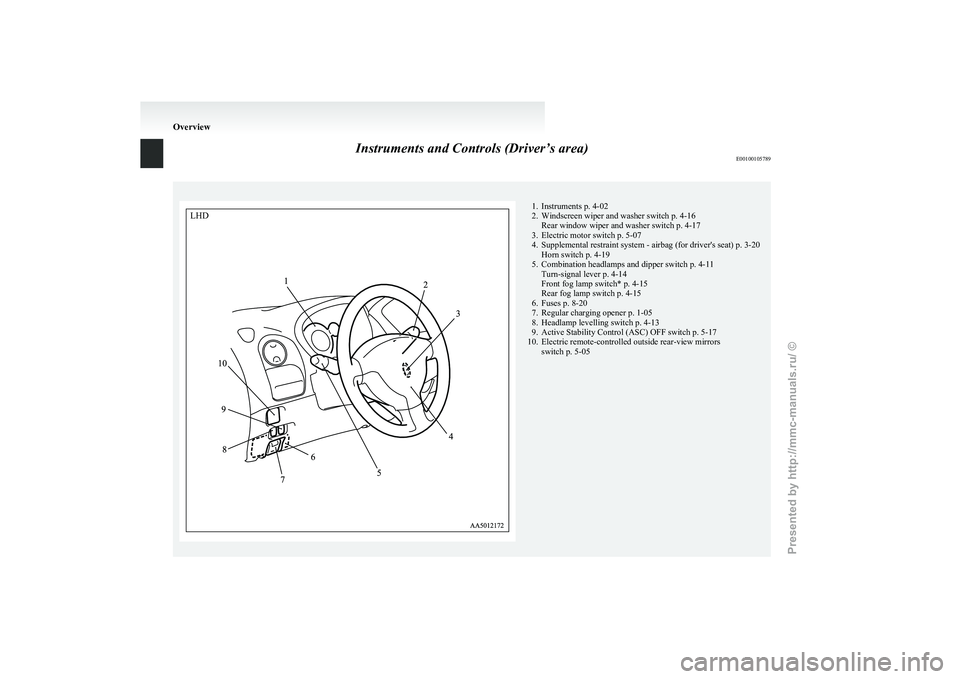
Instruments and Controls (Driver’s area)
E00100105789 1. Instruments p. 4-02
2.
Windscreen wiper and washer switch p. 4-16Rear window wiper and washer switch p. 4-17
3. Electric motor switch p. 5-07
4. Supplemental restraint system - airbag (for driver's seat) p. 3-20 Horn switch p. 4-19
5. Combination headlamps and dipper switch p. 4-11 Turn-signal lever p. 4-14
Front fog lamp switch* p. 4-15
Rear fog lamp switch p. 4-15
6. Fuses p. 8-20
7. Regular charging opener p. 1-05
8. Headlamp levelling switch p. 4-13
9. Active Stability Control (ASC) OFF switch p. 5-17
10. Electric remote-controlled outside rear-view mirrors switch p. 5-05 OverviewLHD
Presented by http://mmc-manuals.ru/ \251
Page 4 of 193
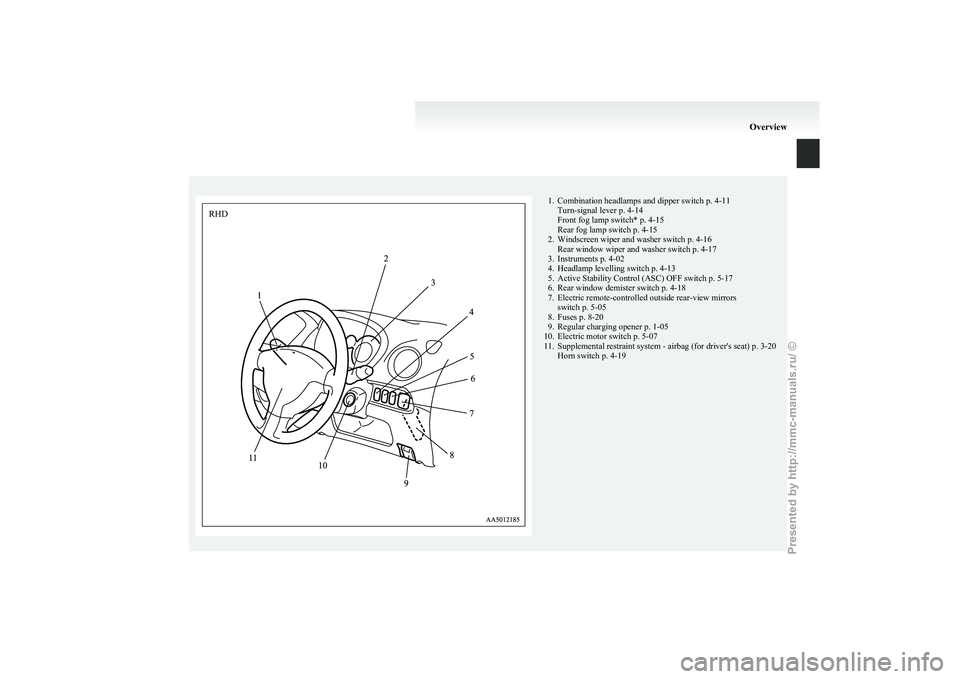
1. Combination headlamps and dipper switch p. 4-11
Turn-signal lever p. 4-14
Front fog lamp switch* p. 4-15
Rear fog lamp switch p. 4-15
2.
Windscreen wiper and washer switch p. 4-16Rear window wiper and washer switch p. 4-17
3. Instruments p. 4-02
4. Headlamp levelling switch p. 4-13
5. Active Stability Control (ASC) OFF switch p. 5-17
6. Rear window demister switch p. 4-18
7. Electric remote-controlled outside rear-view mirrors switch p. 5-05
8. Fuses p. 8-20
9. Regular charging opener p. 1-05
10. Electric motor switch p. 5-07
11. Supplemental restraint system - airbag (for driver's seat) p. 3-20 Horn switch p. 4-19 OverviewRHD
Presented by http://mmc-manuals.ru/ \251
Page 5 of 193

Instruments and Controls (Instrument panel)
E001001057921. Centre ventilators p. 6-02
2.
Hazard warning flasher switch p. 4-15
3. Supplemental restraint system - airbag (for front passen- ger) p. 3-20
4. Side ventilators p. 6-02
5. Cup holder p. 6-15
6. Glove box p. 6-14
7. Bonnet release lever p. 8-07
8. Front passenger’s airbag ON-OFF switch p. 3-23
9. Card holder p. 6-14
10. Rear window demister switch p. 4-18
11. Accessory socket p. 6-11
12. Parking brake lever p. 5-03
13. Cup holder p. 6-15
14. Selector lever p. 5-09
15. Air conditioning p. 6-03
16. Quick charging lid opener p. 1-08
17. Heated seat switch* p. 3-04 OverviewLHD
Presented by http://mmc-manuals.ru/ \251
Page 6 of 193

1. Secret box p. 6-14
2.
Supplemental restraint system - airbag (for front passen-ger) p. 3-20
3. Hazard warning flasher switch p. 4-15
4. Air conditioning p. 6-03
5. Centre ventilators p. 6-02
6. Heated seat switch* p. 3-04
7. Bonnet release lever p. 8-07
8. Quick charging lid opener p. 1-08
9. Front passenger’s airbag ON-OFF switch p. 3-23
10. Selector lever p. 5-09
11. Parking brake lever p. 5-03
12. Cup holder p. 6-15
13. Accessory socket p. 6-11
14. Card holder p. 6-14
15. Glove box p. 6-14
16. Cup holder p. 6-15
17. Side ventilators p. 6-02 OverviewRHD
Presented by http://mmc-manuals.ru/ \251
Page 10 of 193

Outside (Front)
E00100504887 1. Bonnet p. 8-07
2.
Windscreen wipers p. 4-16
3. Antenna p. 6-10
4. Outside rear-view mirror p. 5-05
5. Electric window control p. 2-09
6. Quick charging lid p. 1-08
7. Traction battery p. 8-06
8. Side turn-signal lamps/Hazard warning lamps p. 4-09, 8-24, 8-30
9. Headlamps p. 4-11, 8-24, 8-24, 8-30 Position lamps p. 4-11, 8-24, 8-24, 8-30
Front turn-signal lamps/Hazard warning lamps p. 4-09, 8-24, 8-24,
8-30
10. Front fog lamps* p. 4-15, 8-24, 8-31 Daytime running lamps* p. 4-13, 8-24, 8-31 Overview
Presented by http://mmc-manuals.ru/ \251
Page 11 of 193
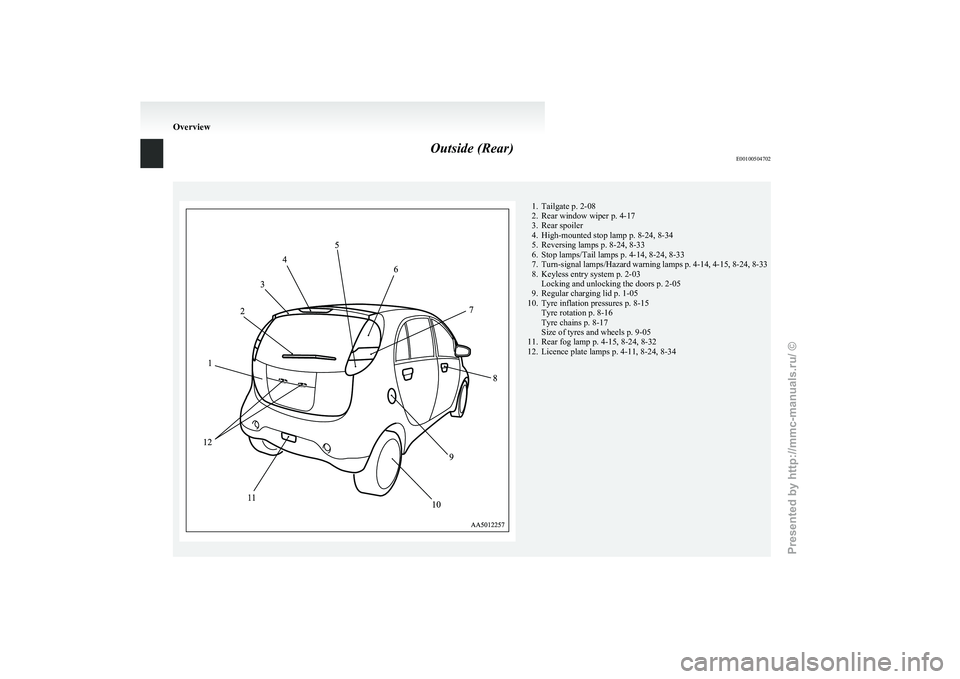
Outside (Rear)
E00100504702 1. Tailgate p. 2-08
2.
Rear window wiper p. 4-17
3. Rear spoiler
4. High-mounted stop lamp p. 8-24, 8-34
5. Reversing lamps p. 8-24, 8-33
6. Stop lamps/Tail lamps p. 4-14, 8-24, 8-33
7. Turn-signal lamps/Hazard warning lamps p. 4-14, 4-15, 8-24, 8-33
8. Keyless entry system p. 2-03 Locking and unlocking the doors p. 2-05
9. Regular charging lid p. 1-05
10. Tyre inflation pressures p. 8-15 Tyre rotation p. 8-16
Tyre chains p. 8-17
Size of tyres and wheels p. 9-05
11. Rear fog lamp p. 4-15, 8-24, 8-32
12. Licence plate lamps p. 4-11, 8-24, 8-34 Overview
Presented by http://mmc-manuals.ru/ \251
Page 13 of 193
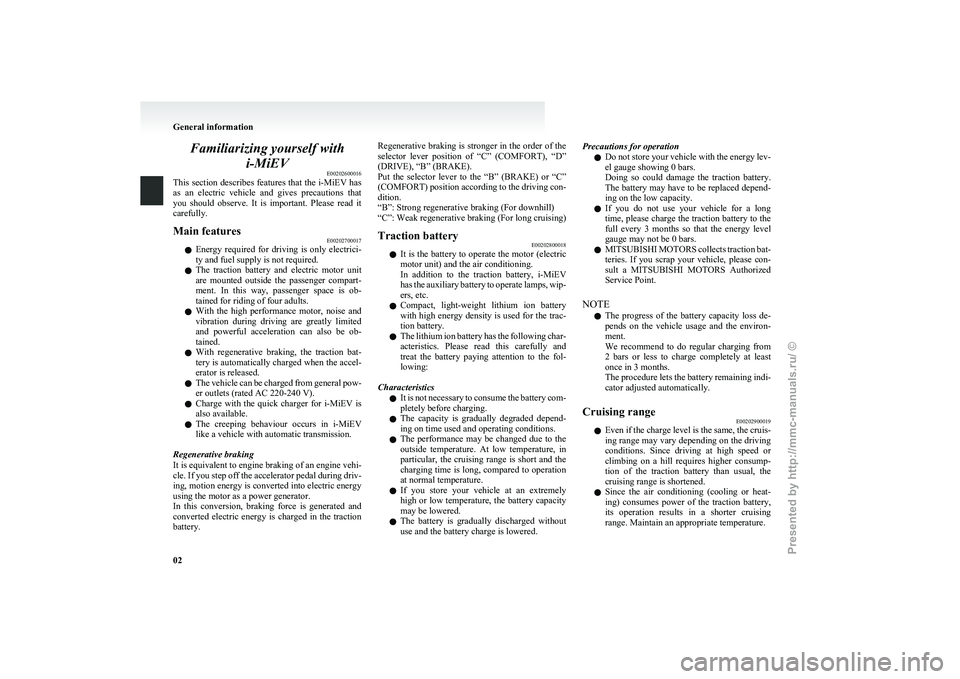
Familiarizing yourself with
i-MiEV E00202600016
This
section describes features that the i-MiEV has
as an electric vehicle and gives precautions that
you should observe. It is important. Please read it
carefully.
Main features E00202700017
l Energy
required for driving is only electrici-
ty and fuel supply is not required.
l The traction battery and electric motor unit
are mounted outside the passenger compart-
ment. In this way, passenger space is ob-
tained for riding of four adults.
l With the high performance motor, noise and
vibration during driving are greatly limited
and powerful acceleration can also be ob-
tained.
l With regenerative braking, the traction bat-
tery is automatically charged when the accel-
erator is released.
l The vehicle can be charged from general pow-
er outlets (rated AC 220-240 V).
l Charge with the quick charger for i-MiEV is
also available.
l The creeping behaviour occurs in i-MiEV
like a vehicle with automatic transmission.
Regenerative braking
It is equivalent to engine braking of an engine vehi-
cle. If you step off the accelerator pedal during driv-
ing, motion energy is converted into electric energy
using the motor as a power generator.
In this conversion, braking force is generated and
converted electric energy is charged in the traction
battery. Regenerative braking is stronger in the order of the
selector
lever position of “C” (COMFORT), “D”
(DRIVE), “B” (BRAKE).
Put the selector lever to the “B” (BRAKE) or “C”
(COMFORT) position according to the driving con-
dition.
“B”: Strong regenerative braking (For downhill)
“C”: Weak regenerative braking (For long cruising)
Traction battery E00202800018
l It
is the battery to operate the motor (electric
motor unit) and the air conditioning.
In addition to the traction battery, i-MiEV
has the auxiliary battery to operate lamps, wip-
ers, etc.
l Compact, light-weight lithium ion battery
with high energy density is used for the trac-
tion battery.
l The lithium ion battery has the following char-
acteristics. Please read this carefully and
treat the battery paying attention to the fol-
lowing:
Characteristics l It is not necessary to consume the battery com-
pletely before charging.
l The capacity is gradually degraded depend-
ing on time used and operating conditions.
l The performance may be changed due to the
outside temperature. At low temperature, in
particular, the cruising range is short and the
charging time is long, compared to operation
at normal temperature.
l If you store your vehicle at an extremely
high or low temperature, the battery capacity
may be lowered.
l The battery is gradually discharged without
use and the battery charge is lowered. Precautions for operation
l Do
not store your vehicle with the energy lev-
el gauge showing 0 bars.
Doing so could damage the traction battery.
The battery may have to be replaced depend-
ing on the low capacity.
l If you do not use your vehicle for a long
time, please charge the traction battery to the
full every 3 months so that the energy level
gauge may not be 0 bars.
l MITSUBISHI MOTORS collects traction bat-
teries. If you scrap your vehicle, please con-
sult a MITSUBISHI MOTORS Authorized
Service Point.
NOTE l The progress of the battery capacity loss de-
pends on the vehicle usage and the environ-
ment.
We recommend to do regular charging from
2 bars or less to charge completely at least
once in 3 months.
The procedure lets the battery remaining indi-
cator adjusted automatically.
Cruising range E00202900019
l Even
if the charge level is the same, the cruis-
ing range may vary depending on the driving
conditions. Since driving at high speed or
climbing on a hill requires higher consump-
tion of the traction battery than usual, the
cruising range is shortened.
l Since the air conditioning (cooling or heat-
ing) consumes power of the traction battery,
its operation results in a shorter cruising
range. Maintain an appropriate temperature. General information
02
Presented by http://mmc-manuals.ru/ \251
Page 16 of 193
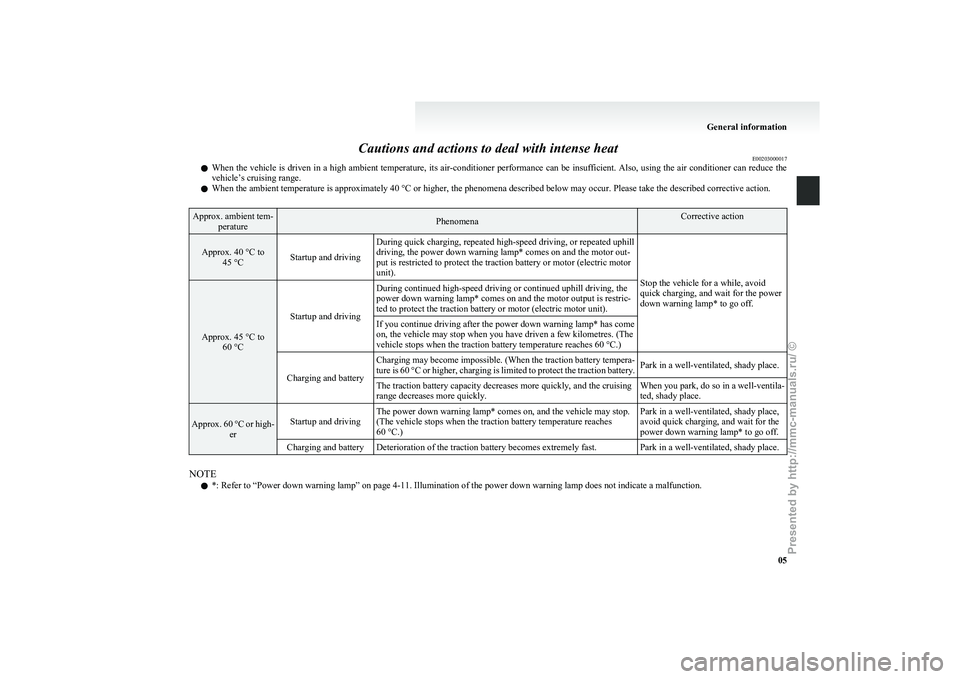
Cautions and actions to deal with intense heat
E00203000017
l When
the vehicle is driven in a high ambient temperature, its air-conditioner performance can be insufficient. Also, using the air conditioner can reduce the
vehicle’s cruising range.
l When the ambient temperature is approximately 40 °C or higher, the phenomena described below may occur. Please take the described corrective action. Approx. ambient tem-
perature Phenomena Corrective action
Approx. 40 °C to
45 °C Startup and driving During quick charging, repeated high-speed driving, or repeated uphill
driving, the power down warning lamp* comes on and the motor out-
put is restricted to protect the traction battery or motor (electric motor
unit).
Stop the vehicle for a while, avoid
quick charging, and wait for the power
down warning lamp* to go off.Approx. 45 °C to
60 °C Startup and driving
During continued high-speed driving or continued uphill driving, the
power down warning lamp* comes on and the motor output is restric-
ted to protect the traction battery or motor (electric motor unit).
If you continue driving after the power down warning lamp* has come
on, the vehicle may stop when you have driven a few kilometres. (The
vehicle stops when the traction battery temperature reaches
60 °C.)
Charging and battery Charging may become impossible. (When the traction battery tempera-
ture
is 60 °C or higher, charging is limited to protect the traction battery. Park in a well-ventilated, shady place.
The traction battery capacity decreases more quickly, and the cruising
range decreases more quickly. When you park, do so in a well-ventila-
ted, shady place.Approx. 60 °C or high-
er Startup and driving
The power down warning lamp* comes on, and the vehicle may stop.
(The vehicle stops when the traction battery temperature reaches
60 °C.) Park in a well-ventilated, shady place,
avoid quick charging, and wait for the
power down warning lamp* to go off.
Charging and battery Deterioration of the traction battery becomes extremely fast. Park in a well-ventilated, shady place. NOTE
l *: Refer to “Power down warning lamp” on page
4-11. Illumination of the power down warning lamp does not indicate a malfunction. General information
05
Presented by http://mmc-manuals.ru/ \251
Page 17 of 193
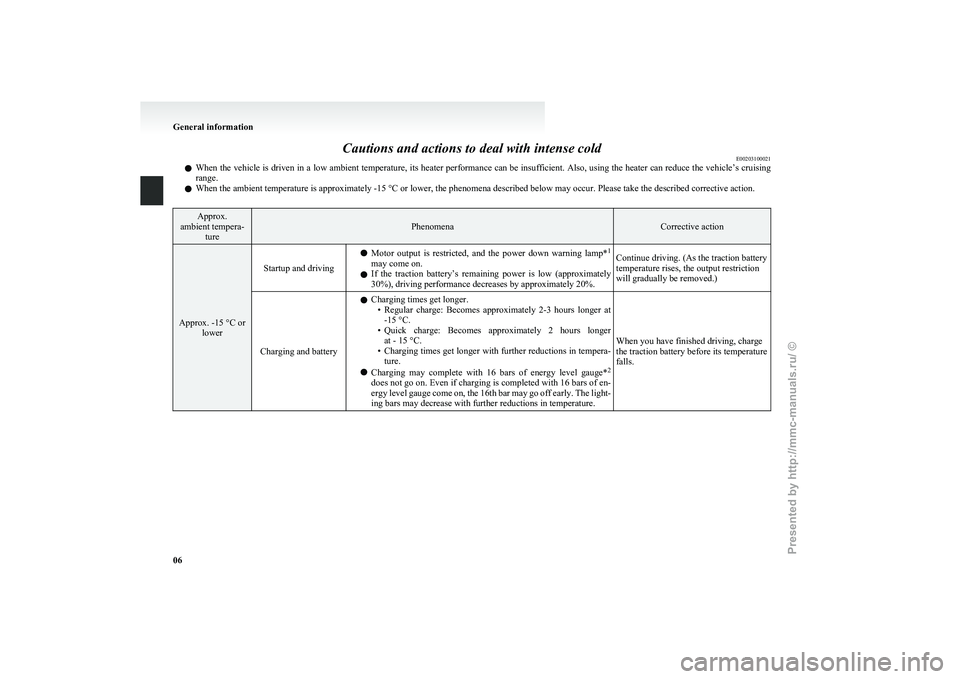
Cautions and actions to deal with intense cold
E00203100021
l When
the vehicle is driven in a low ambient temperature, its heater performance can be insufficient. Also, using the heater can reduce the vehicle’s cruising
range.
l When the ambient temperature is approximately -15 °C or lower, the phenomena described below may occur. Please take the described corrective action. Approx.
ambient tempera- ture Phenomena Corrective action
Approx. -15 °C or
lower Startup and driving
l
Motor
output is restricted, and the power down warning lamp* 1
may come on.
l If the traction battery’s remaining power is low (approximately
30%), driving performance decreases by approximately 20%. Continue driving. (As the traction battery
temperature rises, the output restriction
will gradually be removed.)
Charging and battery l
Charging times get longer.
• Regular
charge: Becomes approximately 2-3 hours longer at
-15 °C.
• Quick charge: Becomes approximately 2 hours longer at - 15 °C.
• Charging times get longer with further reductions in tempera- ture.
l Charging may complete with 16 bars of energy level gauge* 2
does not go on. Even if charging is completed with 16 bars of en-
ergy level gauge come on, the 16th bar may go off early. The light-
ing bars may decrease with further reductions in temperature. When you have finished driving, charge
the traction battery before its temperature
falls.General information
06
Presented by http://mmc-manuals.ru/ \251